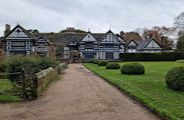
URPoint Details
Dogs on lead only in Stockto's Woods guide dogs admitted.
Disabled parking 50 yds from house disabled visitors may be driven to and collected from stables near house. House: all ground floor rooms easily wheelchair accessible (includes most principal rooms) eighteen six-inch steps to first floor. Garden: easy access to garden and woodland, except steps to west moat garden and mound walk. Toilets in kitchen courtyard. Tearoom has ramp and one two-inch step at entrance ramp available thick handled cutlery available
One of the most famous half-timbered courtyard houses in the country which acquired its present shape during the 16th century, under the ownership of Sir William Morris (d.1506) and his grandson, also Sir William (d.1568) completed (except for some minor additions) for Edward Norris by 1606.
The predominant architectural message of Speke is the decorative potential of wood. The exterior with its high proportion of timber to infill, is a riot of geometrical patterning while many of the Tudor interiors are filled with carved and embellished panelling. Some probably imported from the Low Countries, where the Norris's had trading connections good
Disabled parking 50 yds from house disabled visitors may be driven to and collected from stables near house. House: all ground floor rooms easily wheelchair accessible (includes most principal rooms) eighteen six-inch steps to first floor. Garden: easy access to garden and woodland, except steps to west moat garden and mound walk. Toilets in kitchen courtyard. Tearoom has ramp and one two-inch step at entrance ramp available thick handled cutlery available
One of the most famous half-timbered courtyard houses in the country which acquired its present shape during the 16th century, under the ownership of Sir William Morris (d.1506) and his grandson, also Sir William (d.1568) completed (except for some minor additions) for Edward Norris by 1606.
The predominant architectural message of Speke is the decorative potential of wood. The exterior with its high proportion of timber to infill, is a riot of geometrical patterning while many of the Tudor interiors are filled with carved and embellished panelling. Some probably imported from the Low Countries, where the Norris's had trading connections good
- Type:
- Landmark














